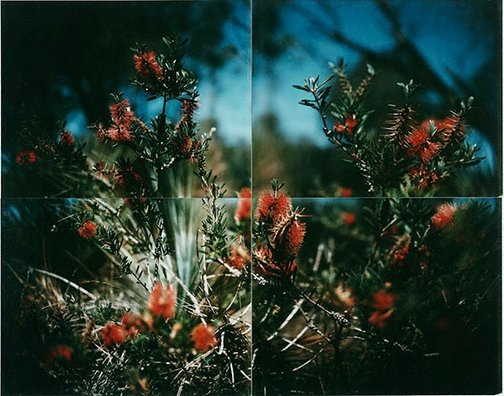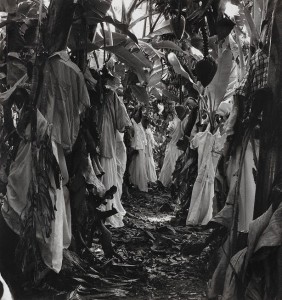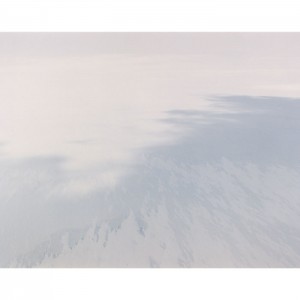When Isobel Philip thinks of the Australian landscape she wonders – which one?
Perhaps I should start this piece of writing with a warning: I am not attempting to produce a comprehensive review of the exhibition Photography & Place at the Art Gallery of NSW. I have no interest in picking apart Judy Annear’s curatorial choices or lamenting what was left out (because this is, for all intents and purposes, a survey show with a strict contextual agenda: Australian Landscape Photography 1970s until Now). I simply want to untangle the thoughts I had as I made my way through the exhibition.
Douglas Holleley, Bottle-brush Near Sleaford Bay, South Australia, 1979, four Polacolour photographs, 61×76 cm.
It is impossible to think of the Australian landscape in absolute terms. It is neither fixed nor defined but composite and mutable. Its only consistency is inconsistency. From the coast to the rain forests, the mountain ranges to the deserts, it is hard to believe such divergent topographies can share a common space.
When I try to summon a single image of the Australian landscape I am not only faced with disparate fragments – a bit of the coast, a corner of a mountain – but with gaps. There are parts of this country I don’t know and cannot even imagine. To think of the Australian landscape, for me anyway, is like being confronted with a collage dominated by negative space rather than concrete images. One has to embrace the ellipsis.
Simryn Gill, From Rampant, 1999, gelatin silver photograph, 52×49 cm
What stuck me as I moved through Photography & Place was how the gaps – these absences – that dominated my mental picture of the Australian landscape were not simply articulated in the space between the individual works but also within them. For me, the most striking thing about this show was the way it voiced absence – the way it spoke through silence.
I was aware of this from the outset. Taken from the window of a car moving through the country, Wesley Stacey’s photographs, from the sequence Outback to the City, Folio 1 in The Road, are as much about what lies beyond the frame than what is featured within it. With their focus on the microscopic fragment, Douglas Holleley’s tessellating Polaroids embody this notion of the land as collage quite literally. And yet in these photographic mosaics something is amiss. The forms and lines of each ‘snapshot’ aren’t perfectly aligned. These are ruptured landscapes.
In Lynn Silverman’s work I was more interested in the space between each set of paired images – each distant horizon line and close-range aerial shot of the ground. It was this space, the space between proximity and distance, that caught my eye.
As I moved through the exhibition I began to detect a subtle shift. In these later works the articulation of ‘absence’ or the gap is often the central subject. Here the gap does not simply manifest at the edge of the image – in the peripheral space surrounding the photograph – but at its centre.
The bare patches of grass in Anne Ferran’s Lost to World series – all that remains of various Tasmanian convict sites – are temporal residues. These photographs collapse the present into the past and extract meaning out of absence. Simryn Gill’s series Rampant addresses a similar phenomenon. Here the white cotton shirts and dresses scattered across the tropical landscape, draped over the trees, are like phantom figures. Their sagging bodies quietly mourn absent limbs.
Turning to an adjacent wall I came face to face with another spectral form in the thin layer of mist that seeps into Paul Ogier’s photographs of nuclear bomb testing sites. These spaces seem haunted, otherworldly even.
David Stephenson, Ice 4 (from the series The Ice), 1992, type c photograph, 61×76 cm.
Where Ogier’s work gently moves away from the concrete and the tangible, Simone Douglas and David Stephenson withdraw from it completely. Both Douglas’s unfocused and blue tinted landscape series Blind and Stephenson’s Antarctic ice-scapes – where the difference between land and sky is completely imperceptible – move into the realm of the transcendental. These works were fragile and profound in the very same instant.
The conceptual thread I had traced throughout the entire exhibition culminated in Douglas and Stephenson’s work. These works do not announce a constant or total landscape but whisper its delicate, fluctuating and intangible forms. As I see it, the whole exhibition works in and around this very premise. What matters here is not that which remains visible – that which shouts out at you from the centre of the image – but what is left unsaid, what is lost within the ellipsis.
Photography and Place
Art Gallery of NSW
Until May 29 2011.




Pien de medre! What a crap show on this great and varied landscape! The worst curatorial practice – and the most boring photography show on earth! Shame AGNSW!